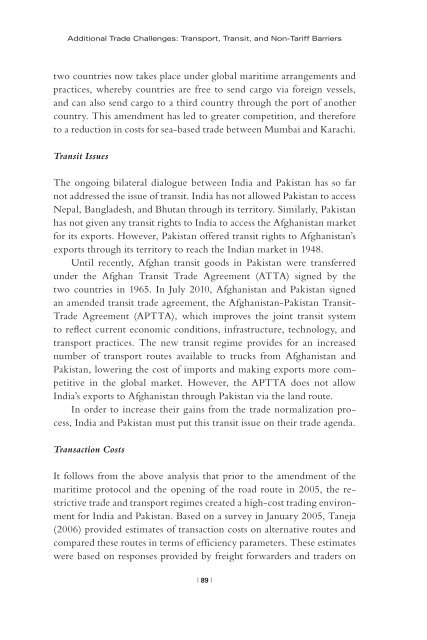You also want an ePaper? Increase the reach of your titles
YUMPU automatically turns print PDFs into web optimized ePapers that Google loves.
Additional <strong>Trade</strong> Challenges: Transport, Transit, and Non-Tariff Barriers<br />
two countries now takes place under global maritime arrangements and<br />
practices, whereby countries are free to send cargo via foreign vessels,<br />
and can also send cargo to a third country through the port of another<br />
country. This amendment has led to greater competition, and therefore<br />
to a reduction in costs for sea-based trade between Mumbai and Karachi.<br />
Transit Issues<br />
The ongoing bilateral dialogue between <strong>India</strong> and <strong>Pakistan</strong> has so far<br />
not addressed the issue of transit. <strong>India</strong> has not allowed <strong>Pakistan</strong> to access<br />
Nepal, Bangladesh, and Bhutan through its territory. Similarly, <strong>Pakistan</strong><br />
has not given any transit rights to <strong>India</strong> to access the Afghanistan market<br />
for its exports. However, <strong>Pakistan</strong> offered transit rights to Afghanistan’s<br />
exports through its territory to reach the <strong>India</strong>n market in 1948.<br />
Until recently, Afghan transit goods in <strong>Pakistan</strong> were transferred<br />
under the Afghan Transit <strong>Trade</strong> Agreement (ATTA) signed by the<br />
two countries in 1965. In July 2010, Afghanistan and <strong>Pakistan</strong> signed<br />
an amended transit trade agreement, the Afghanistan-<strong>Pakistan</strong> Transit-<br />
<strong>Trade</strong> Agreement (APTTA), which improves the joint transit system<br />
to reflect current economic conditions, infrastructure, technology, and<br />
transport practices. The new transit regime provides for an increased<br />
number of transport routes available to trucks from Afghanistan and<br />
<strong>Pakistan</strong>, lowering the cost of imports and making exports more competitive<br />
in the global market. However, the APTTA does not allow<br />
<strong>India</strong>’s exports to Afghanistan through <strong>Pakistan</strong> via the land route.<br />
In order to increase their gains from the trade normalization process,<br />
<strong>India</strong> and <strong>Pakistan</strong> must put this transit issue on their trade agenda.<br />
Transaction Costs<br />
It follows from the above analysis that prior to the amendment of the<br />
maritime protocol and the opening of the road route in 2005, the restrictive<br />
trade and transport regimes created a high-cost trading environment<br />
for <strong>India</strong> and <strong>Pakistan</strong>. Based on a survey in January 2005, Taneja<br />
(2006) provided estimates of transaction costs on alternative routes and<br />
compared these routes in terms of efficiency parameters. These estimates<br />
were based on responses provided by freight forwarders and traders on<br />
| 89 |


